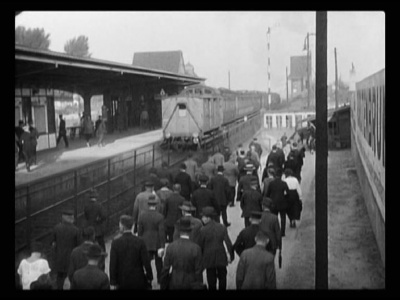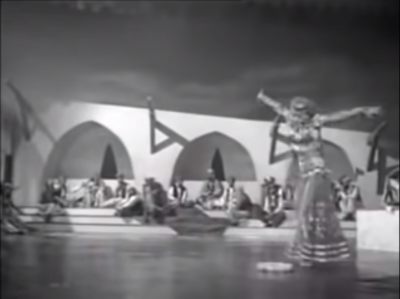
From the left: dr Grzegorz Welizarowicz and prof. Jesse Lerner
How did Argentina's reluctant declaration of war on the Third Reich influence the golden age of Mexican cinema? Why did a Taco Bell restaurant in Mexico City fail after less than two years? We asked prof. Jesse Lerner of the Claremont Colleges, who came to the University of Gdansk as part of the Visiting Professors program. The American film scholar and director took part in the International Border Studies Center UG conference and led a film workshop for UG students.
Marcel Jakubowski: - What are you doing during your visit at University of Gdańsk?
Jesse Lerner: - I'm teaching a workshop with a group of students from the university. We're making a short film about a day in the life in the city of Gdańsk. The students are doing the shooting and the editing, I’m their artistic consultant. The inspiration for the project came from the type of movie popular in the 1920s – city symphony. Those films showed life in big metropolises like Berlin, Paris or San Paulo. But they were usually about much more than just a city, like the Man with a Movie Camera (1929) by Dziga Vertov, that has a reflective element as well. I'm also doing a number of lectures and classes both here at the University of Gdańsk and next week at the Museum of Emigration. As part of the International Border Studies Center UG conference that begins next Tuesday, I'm also showing some of my films: The Absent Stone (2013) co-created with Sandra Rozental, first movie I made by myself - Ruins (1999) and Frontierland (1995) co-created with Rubén Ortiz Torres. On Friday, we're going to show both the city symphony that we will have made in the workshop and my most recent film, which is called The Fragmentations Only Mean…(2022) made in collaboration with Sara Harris.

Berlin: Symphony of a Great City (1927), dir. Walter Ruttmann
- City symphonies from the 1920s usually show the characteristics of the place which they are about. What values of Gdańsk do you want to emphasize in your film?
This is only my second time here, so I don’t know the city very well. It's really the students that are directing and selecting the locations, but the idea is that we're trying to show 24 hours in the life of the city. 24 different neighborhoods and areas of Gdańsk. In line with the IBSC conference, we are thinking of Gdańsk as a border city. So we filmed the port, where Polish products go out to the rest of the world and where things from the West arrive. We're shooting at the airport, which is another kind of interface between the city and the rest of the planet. Also, there won’t be any shortage of integral areas of Gdańsk, like the beach, or the Old Town. Everything will be divided by hours. One hour of the day equals to a minute of a movie. Every minute shows a different place, with different people and different characteristics. We are trying to create something in line with the city symphonies of the 1920s, which were this kind of kaleidoscopic, complex looks at neighborhoods, jobs, social classes and recreational activities.
In your academic publications, you focus mostly on the Cinema of Mexico. You also make movies about the Mexican reality. What interested you most about this country?
I'm showing a variety of four different films of mine, three of them deal with Mexican history or culture in a variety of different ways. The one I'm showing next week at the Border Seminar 2023 is very much about US and Mexican relationships. It’s called Frontierland. We were trying to show how there is a Mexican version of US culture, US version of Mexican culture and also a Mexican version of US version of Mexican culture. Because of this back and forth, it's sort of a border film. The inspiration for the movie came from the time, when someone decided to open up a Taco Bell - a very gringo version of Mexican food - in Mexico City. It went out of business pretty quickly.
It's like opening Pizza Hut in Italy.
Yes, serving to locals the appropriated version of their own food.

"Aventurera" (1949) dir. Alberto Gout
When was Mexican cinema in its golden age?
The golden age is often used to refer to Mexican cinema in the second part of the 1940s and the early part of the 1950s. In the silent era(1895-1927), it was very easy for films to circulate internationally, because you only needed to translate the intertitles. When technology to put in the sound arrived, people weren't quite sure how to adapt these films for different audiences, especially in Mexico, where at the time a lot of people couldn’t read very well. There was this thought in Hollywood, that they could make the same movie twice in one day. First shoot English-speaking cast and then bring in Spanish-speaking actors at night. They used the same sets, camera angles etc. That didn't work for a variety of reasons. For example, in the 1930s people wanted to see Dracula (1931), because of Bela Lugosi. If you have this Latino actor in his place, it's the same movie, but without the star. There was also an issue with accents, because everybody in Latin America, except for the Brazilians and some French colonies in the Caribbean, speak Spanish. But they don't speak the same Spanish. There is Argentinian Spanish, Cuban Spanish or Mexican Spanish. I think that North American producers weren't very aware of that. They would cast a Cuban actor and an Argentinian actress as brother and sister. It made no sense, that those two people would be related. So for a variety of reasons, this idea of making Hollywood films in Spanish for the Latin American audience didn't work. The second cause for the golden age was the fact that Argentina didn't declare war on the Nazis until the beginning of 1945. Because of that the US said, that they're not going to trade with them. Argentina was using Kodak stock from New York, so their film industry collapsed after the war. Mexico saw this gap in the market and started making these really wonderful films for the entire Latin America. Usually the term “Golden Age” is referring to the second part of the 1940s. But a lot of people also say, that we are experiencing the Golden Age of Mexican Cinema right now.
Roma (2018) was the first movie from Mexico to win an Oscar for Best Foreign Film.
Yes. Roma by Alfonso Cuarón, but there is also Guillermo del Toro or Alejandro González Iñárritu. All these guys keep on winning Oscars. It's a good time for Mexican cinema.
Besides being a filmmaker, you are also a university professor. Is the theoretical background advantageous during the shooting of a movie or does it get in a way?
I think it's an advantage. The way, in which you make films, is informed by your reading and film theory. There's an Italian Marxist theoretician Antonio Gramsci, who said that the theory informs the practice and the practice informs the theory.
What movement or subgenre of documentaries inspired you the most as a filmmaker?
I was trained in a very kind of orthodox observational cinema, but that's not the style that I'm interested in. I like the experimental documentaries that play with its form or think about the way, in which the content might inform the form and vice versa. If you look at films that I am showing during my stay, there's always some kind of dialogue between what the film is representing and the way in which the film is representing it. In the case of Frontierland, which about Mexico and the United States. Since it's about hybridity, the combination of both US and Mexican culture, we’ve shot different parts of the movie on different formats. There's one part that's video, one that's black and white and one part that's Super 8 color. We’ve also used different film language. One part looks like a history channel documentary with a narrator, one part looks more like an underground punk movie and another part looks like an art film.

One of the Noah Purifoy's sculptures
How did you adapt the form to the subject with your last movie - The Fragmentations Only Mean …(2022)?
There's a place in the desert near Joshua Tree, about 100 miles from Los Angeles. This artist, Noah Purifoy, a retired arts administrator, wanted to move back to LA, but it was too expensive. One of his friends convinced him to come out to the desert. That’s how Noah ended up with this 12 acre lot. Over the last 15 years of his life, he made more than 100 of sculptures from garbage. Some of them are more abstract or formal, and some have more explicit political messages. All of them are in what is now called Noah Purifoy Outdoor Museum. We thought it was a good subject for a movie. The style should correspond to the sculptures, so reusing something thought to be worthless, right? We decided that an equivalent to that in film language would be an assemblage of “junk dada”. We shot on Super 8 and with these plastic, toy cameras. Then we scanned the film and chopped it to pieces, so we could create these crazy Frankensteins montages.
From what I saw, you usually shoot on film. During a shooting of documentaries, there's this incentive usually to never cut. But when you shoot on film, your time is limited. Does this changes how shoot your films?
I don't feel the impulse to never cut. The Soviets, especially Sergei Eisenstein thought that we create filmic meaning by montage. He said, that 1 + 1 = 3. If you have two shots, and you put them together in a certain kind of way, there's this additional third values that comes from juxtaposition. So rather than following my subject around with the camera and shooting long takes. I'm trying to create meaning through the montage.
Could you recommend some Latin American and Mexican movies for someone, who has never seen one?
I was part of this project called “Ism, Ism, Ism: Experimental Cinema in Latin America” with Luciano Piazza, which was a collaboration between a small group of curators. We put together this touring program of experimental Latin American film. If you look at a history of experimental film, it's almost always cinema from the United States, Canada and Western Europe. History of Latin American film is a history of feature length films, maybe occasional documentary, but no experimental films. Somehow this part of Latin American cinema got lost. We did about 100 or so different screenings of about 30 different programs. I really like some of the Argentinian Super 8 films from the 1970s. We showed this parody of the documentary with a social commentary from Colombia called Agarrando Pueblo(1977)(Vampires of Poverty). Those films aren't very well known, but deserve more exposure. We put together this bilingual publication with the University of California called “Ism, Ism, Ism”.
Thank you, for this conversation.
Thank you.
